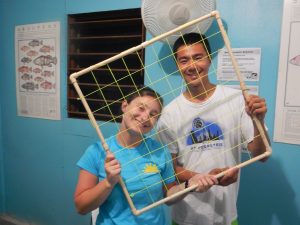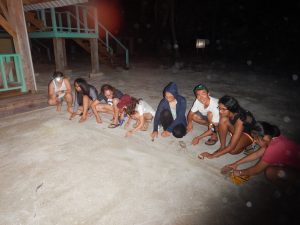-
Why must good things come to an end?
Today was a day of many lasts: snorkeling at Glover’s Atoll, sitting at the pier with the squad, and interacting with the lion fish. The post-Belize depression will be real but I will be sure to return to this lovely, peaceful, and unbelizeable place (credit: Sami).
First things first: food was amazing today. After dissecting the lion fish we have gotten from the surrounding reefs, Chef Scott turned the white meat fish into a delicious bowl of ceviche, lime-marinated fresh fish mixed with diced onion and tomato.

10/10 would eat again! Even the vegetarians helped finish the fish, an environmental friendly act due to the lionfish’s devastating effect on native fish species. Nonnative to this region, the piescivorous lion fish feed on smaller fish that are native to the region, at a disproportionally high rate. This causes up to 70% decrease in
native fish populations.
A similar trend can be said of brown algae, Sargassum seaweed in particular, which has crowded out large populations of coral because of its ability to grow from dissembles parts of itself and its tolerance to hot water.
At the Southwest Caye of Glover’s Atoll, we hung out at the resort and savored the beverages that the Caribbean had to offer, including Belizean pineapple Fanta which instead of using corn syrup as sweetener uses cane sugar. We noted the amount of conch shells on the island and thought about the regulations in place at this region for conch fishing. We hope they weren’t collected from restricted fishing zones, weren’t undersized, or caught during the mating season.
As our pilot research project has shown, marine protected areas support more corals and number of species, which can be worthy contributions to the coral reef ecosystem. Illegal harvesting of conch would instead be a detraction.
In the waters around Southwest Caye, we observed the abundant sargassum seaweed. They are especially obvious because of they float free on the surface of water. Under water around the patch reefs near Middle Caye, I saw a lot of lobophora and White scroll algae. Most of these algae communities are near or inside coral communities, and share their habitat with many species of fish, spiny brittle star, and anemones. If one made a conclusion about the role of algae in the coral reef ecosystem from these observation, it may be that algae seems to be living in good relationships with its neighboring corals. However, comparing the algae and coral compositions of today to that of the last couple decades, the correlation between algae growth and coral decline can be alarming. We wonder if our grandchildren will see the corals that we got to see today.
For about a week now we have been coordinating a group mediation.
Alas, tonight we meditated together as a class and some of us mentally prepared ourselves for the end of what feels like an era.
Tag Archives: Sargassum
Quadrats, not quadrants!
Day 1 of Beach Days, 5/23.
My day began in the savanna cabanas of the tropical education center and it is about to end in a hammock on the Middle Caye of Glover’s Atoll. The view has changed drastically. Compared to the 100 meter visibility in the savanna, my view here at Glover’s is only cut short by the horizons. In this grand view, I see faraway lightning that may be associated with a brewing tropical storm. But because it is likely more than hundreds of miles away, I cannot hear the thunder.
This is our first day at the beach and it has mostly felt like vacation. We travelled to a marina in Belize City to catch a 3-hour boatride to Glover’s. On the way we saw the difference between deep and shallow water, and a myriad of other islands in the area. One constant object I observed was the availability of Sargassum on the ocean surface, some of which were cut up by the motors on our boat. Before I knew exactly what I was looking at, Scott and Jessica yelled out to me asking me to identify the green floating algae. With the amount of intensity and excitement they yelled at me, I understood it must have been something obvious: they are the Sargassum seaweed that has been infesting many coral reef areas, outcompeting many other species of corals and causing their decline. They are a group of brown algae that utilizes fouaxin to photosynthesize which gives them a slightly redder and browner color, although they also have the green pigments that come with chlorophyll. They are also the only species of red and brown algae that has air bladders, allowing them to trap air within the organism.
After arrival, we practiced snorkelling, a follow up to to first practice we had on campus in the recreational pools. This time we were surrounded by bone fish, nurse sharks, stingrays, corals, and jellyfish. The most difficult aspect of this practice was not touching things we should’t touch: corals, stingray and wildlife in general. Compared to the rainforest, where we were able to put our hands on almost anything that we were able to catch, the corals here are very fragile and many animals here are hidden and able to be aroused if touched, such as stingrays. With the construction of marine-use guadrats, we will be exploring and initiating contact with corals and perhaps a Echinoderm or two. The key is to not destroy the wildlife and no let the wildlife destroy us.
Stay tuned to find out how to best place quadrats on corals!

ANGUS crab
Day 3 of Beach Days
Today’s activity definitely took a toll on us — but our Dermit Rab made it all better.

We woke up, ate, and swam to the edge of the thousand-feet-drop in the benthos (sea floor). On the way, the supposedly calm waters rocked us to differing degrees of sea sickness. In the water we went in all different directions with regards to the waves, on which we bobbed up and down while we looked in the deeper ocean for interesting life forms. One of the forereefs we explored was geographically filled with canyons of corals. Centuries of wave engergy shaped the current-day grooves filled with hard and soft corals, among other life forms. We observed an especially problematic species of fish, called the lion fish, camouflouging in the corals today. Their presence in this region, which is far from their native rainge, has caused up to 70% decline in native fish populations. Obviously, we speared them and brought them back to dissect, fry, and eat. Which is a prospect even the “vegetarians” are supporting.
In the afternoon, we quanitified the degree of biodiversity of Echinoderms (particularly sea urchins) in a protected and an unprotected marine area. Which means we spent an hour spotting and picking off the spiny sea urchins from dead corals and algae on which they are grazing. While searching for sea urchins, I saw two types of brown algae, specifically, they were two types of white-scrolled algae. One has a darker base and the other a lighter color, but both have a characteristic curly shape that resembles a scroll. In addition, we came into contact with Sargassm seadweed again, which is more or less impossible not to come into contact with due to their prevalence and distribution on the ocean surface. In addition we observed many blister saucer algae, both attached to corals and floating on the surface. Interesting, they too, like the Sargassum, are able to keep some air within their chambered body so that when squished air bubbles are released. Although they do not have a characteristic air bladder like the sea weed, these saucer algae had triangular bulbous organs to hold air.
In the evening, we had one of the best meals we’ve had yet — consisting of flan, spiced chicken, banana bread, lemon cookies, homemade bread, and mashed potato. After our lectures, we collected blue crabs and hermit crabs to race in the sand. Among 5+ competitors, one travelled in the opposite direction, 1 paused, and 2 finished close to each other. It seems like the large hermit crabs are the best for Dermit Rab. Also obvious that blue land crabs are not the best as they walk side ways and are prone to going to dark places to hide. Angus, me and Claire’s contestant, although big, did just that. :/
The communal nap I have been predicting and advocating for — also happened today! Our tiredness has come to an all time high, but with proper rest, i.e. communal naps, we seem to be a very resilient group.
